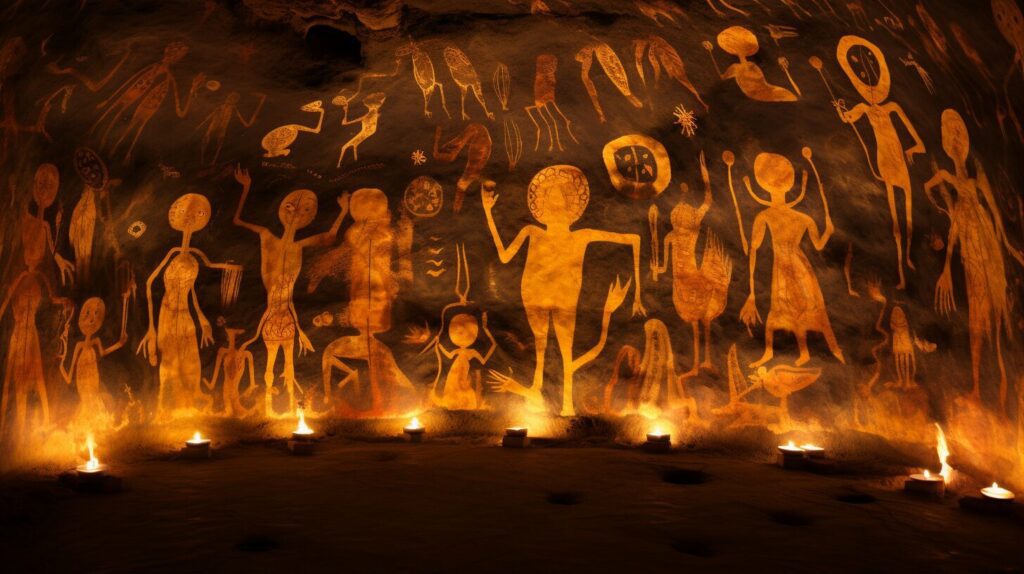Shamanic Healing Practices

Welcome to our exploration of shamanic healing practices, where we delve into the historical essence and modern evolution of this transformative spiritual journey. Shamanism, a practice deeply rooted in community, has been instrumental in helping and healing societies for centuries. From ancient rituals to contemporary adaptations, shamanic healing continues to hold great significance in our quest for holistic well-being.
Shamanic practices date back to humanity’s earliest mystic traditions, such as the Paleolithic era, where shamanic rituals were depicted in cave art and artifacts. These practices have evolved over time, shaping cultures and spirituality, while still maintaining their core essence. Today, modern adaptations of shamanic healing offer a blend of ancient wisdom and contemporary approaches, providing profound healing experiences for individuals seeking spiritual growth.
Understanding Shamanic Rituals: Insights into the Practices and Symbolism
Shamanic rituals are fascinating practices that involve a range of activities aimed at promoting healing and spiritual connection. These rituals often incorporate imitation, miming, and rhythmic activities, which serve to enhance social bonding and facilitate a deeper understanding of the shamanic experience. By engaging in these rituals, individuals are able to tap into their subconscious mind and access the hidden realms of the spirit world.
Symbolization and metaphor-making are also integral elements of shamanic rituals. Through the use of symbols and metaphors, shamans are able to explore profound emotional experiences and create meaning from the unknown. This allows individuals to process emotional residues and gain insights into their own spiritual journey. The act of symbolization also extends to the natural world, where shamans project human qualities onto animals and other natural agents, creating a rich and vibrant “spirit world” filled with benevolent and malevolent beings.
In understanding shamanic rituals, it becomes evident that these practices have a profound impact on the human brain. The rhythmic activities and intense focus achieved during these rituals promote brain wave synchronization and engage both cortical hemispheres. This leads to changes in brain activity, including heightened serotonin levels and relaxation responses. It is through this altered state of consciousness that shamans are able to access information beyond ordinary perception and facilitate deep healing on multiple levels.
The Power of Drumming in Shamanic Rituals
One of the most significant aspects of shamanic rituals is the power of drumming. The rhythmic beating of the drum serves as a gateway to altered states of consciousness, aiding in relaxation and inducing a trance-like state. The repetitive sound of the drum helps to synchronize brain waves and promote a sense of unity and connection with the spiritual realm. Shamans often use drumming as a tool to enter into a meditative state and facilitate a deeper connection with their spirit guides and power animals. The power of drumming in shamanic rituals cannot be overstated, as it serves as a powerful catalyst for spiritual transformation and healing.
In conclusion, understanding shamanic rituals provides valuable insights into the practices and symbolism that underpin this ancient form of healing and spiritual connection. By engaging in imitation, miming, and rhythmic activities, individuals are able to enhance social bonding and tap into the deeper realms of the spirit world. Symbolization and metaphor-making play a crucial role in shamanic experiences, allowing for the creation of meaning from the unknown. The power of drumming amplifies the effects of shamanic rituals, facilitating altered states of consciousness and promoting spiritual transformation. Through understanding these rituals, we gain a deeper appreciation for the rich and profound world of shamanism.
The Role of Spirit Animals in Shamanism: Connecting with Animal Guides
In shamanism, spirit animals, also known as power animals, play a crucial role in connecting practitioners with the natural world and serving as guides in their spiritual journeys. These animal allies are believed to possess qualities and wisdom that can assist shamans in healing, protection, and navigating the spiritual realm. By forging a deep connection with their spirit animals, shamans gain access to valuable insights and guidance that can aid in identifying natural agents and facilitating therapeutic changes.
The relationship between shamans and their spirit animals is characterized by a deep sense of respect and reciprocity. Shamans believe that these animals hold unique spiritual powers and can act as intermediaries between the human and spirit worlds. The power of spirit animals lies not only in their symbolism but also in their embodiment of natural energies and qualities that shamans can tap into during their healing practices.
“The spirit animal is like a second self, embodying qualities that we need to learn, develop, or cultivate. They help us understand ourselves better and guide us on our spiritual path.”
Shamans use various methods to connect with their spirit animals, including meditation, dreams, and rituals. Through these practices, shamans seek to establish a strong bond with their animal allies, enabling them to receive messages and guidance from the spiritual realm. As a result, shamans are able to identify natural agents, such as medicinal plants or game, with the help of their spirit animal guides.
Connecting with Your Own Spirit Animal
If you are interested in exploring the role of spirit animals in your own life, there are steps you can take to establish a connection. Begin by setting the intention to connect with your spirit animal and be open to receiving their guidance. Pay attention to any recurring animal symbols or encounters in your dreams or daily life, as these may be signs from your spirit animal. Reflect on the qualities and behaviors of these animals and how they may relate to your own life journey.
Engaging in meditation or visualization practices can also aid in connecting with your spirit animal. Find a quiet and peaceful space, close your eyes, and imagine yourself in nature. Allow yourself to be open and receptive to any animals that may appear to you. Trust your intuition and the messages you receive during these practices.
Remember, the connection with your spirit animal is unique to you. Embrace the guidance and wisdom they offer, and let their presence guide you on your spiritual journey.

Section 4: Shamanic Journeying and Meditation: Exploring Altered States of Consciousness
Shamanic journeying and meditation are powerful practices that allow individuals to explore altered states of consciousness, opening the door to the realm of the spiritual and gaining insights, healing, and guidance. In these altered states, shamans embark on spiritual journeys, connecting with the spirit realm to seek wisdom and understanding.
The process of shamanic journeying involves inducing trance-like states, often facilitated by drumming, chanting, or the use of psychoactive substances. These altered states enable shamans to access different realities, recall valuable information, and explore options for future behavior. Similar to dreaming, shamanic journeying involves the use of symbolism and metaphor-making, allowing for deeper understanding and transformation.

Trance states and altered consciousness are essential for shamans to access information beyond ordinary perception. By entering these states, they can navigate the spiritual realm, access healing energies, and receive messages from spirit guides. Shamanic journeying and meditation provide a means for individuals to connect with their inner selves, expand their consciousness, and tap into the collective wisdom of the universe.
To truly understand the transformative power of shamanic journeying and meditation, it is important to experience it firsthand. Through these practices, you can access profound insights, heal emotional wounds, and cultivate a deeper connection with the spiritual realm. The exploration of altered states of consciousness is a gateway to spiritual awakening and personal growth, offering a path to greater self-awareness and alignment with the divine.
Historical Perspective of Shamanic Practices: Tracing the Origins of Shamanism
Shamanism, as a mystical practice, has its roots in humanity’s earliest history, dating back to the Paleolithic era. Prehistoric cave art and artifacts provide valuable clues to the existence of shamanic practices during this period. These ancient depictions often show humans in trance-like poses, accompanied by animal symbolism and references to journeys into the spirit world. The Paleolithic shamans utilized these practices to navigate the challenges of their environment and connect with the spiritual realm.

Shamanism was a vital part of hunter-gatherer societies, serving as a means of survival and a way to understand the mysteries of the natural world. The practices evolved in response to the needs of these early communities, shaping human thought, culture, and spirituality. Shamanic rituals, involving dance, drumming, chanting, and spirit communication, played a crucial role in aiding and healing the community. These rituals released opioids, reduced pain, and promoted natural healing processes.
| Key Points: | |
|---|---|
| Shamanism has its roots in the Paleolithic era. | Shamanic practices can be traced back to prehistoric cave art. |
| Shamanism evolved as a means of survival and understanding the natural world. | Shamanic rituals played a crucial role in aiding and healing communities. |
| These rituals released opioids, reduced pain, and promoted natural healing. |
Spiritual Connections through Cave Art
One of the most significant pieces of evidence for the historical perspective of shamanic practices is the existence of prehistoric cave art. These artistic depictions provide insights into the spiritual beliefs and experiences of early humans. The symbolism and imagery found in these caves suggest the importance of shamanic rituals and their connection to the natural and spiritual worlds.
“Cave art provides a window into the spiritual lives of our ancestors,” says archaeologist Dr. Jane Davis. “The representations of animals and humans in these artworks reveal a deep reverence for the natural world and the belief in a spiritual realm that could be accessed through shamanic practices.”
“Cave art provides a window into the spiritual lives of our ancestors. The representations of animals and humans in these artworks reveal a deep reverence for the natural world and the belief in a spiritual realm that could be accessed through shamanic practices.” – Dr. Jane Davis, Archaeologist
Through the study of prehistoric cave art, researchers have gained valuable insights into the origins and evolution of shamanism. These ancient practices laid the foundation for the development of spiritual traditions that continue to shape human culture and understanding today.
Shamanic Drumming and Its Significance: The Rhythm of Connection and Healing
Shamanic drumming is a core element of shamanic rituals, playing a significant role in facilitating rhythmic activities that enhance social bonding and brainwave synchronization. The rhythmic beating of the drum creates a trance-like state, allowing shamans to enter altered states of consciousness and connect with the spiritual realm. The repetitive rhythm of the drum induces relaxation responses and releases opioids that reduce pain, promoting a sense of calm and well-being.
The significance of shamanic drumming lies in its ability to connect cortical hemispheres and higher and lower brain centers, fostering an integrative mode of consciousness. It helps shamans access information beyond ordinary perception and facilitates healing on multiple levels. The rhythmic activities and brainwave synchronization induced by shamanic drumming promote a sense of unity and connection, both within the individual and with the larger community.
Shamanic drumming can be likened to a heartbeat, symbolizing the rhythm of life and the interconnectedness of all beings. The steady beat of the drum creates a focused and meditative state, allowing shamans to journey into different realities, recall valuable information, and explore different options for behavior. It is through this rhythmic connection that shamans access the wisdom and guidance of the spirit world, bringing back insights and healing energy for the benefit of the individual and the community as a whole.

The Power of Rhythm
Rhythm is a universal language that transcends cultural boundaries. It has the power to synchronize brainwaves, evoke emotions, and create a sense of unity. In shamanic rituals, rhythmic activities such as drumming, chanting, and dancing serve as vehicles for healing and spiritual transformation.
The drum is the pulse of the shaman, the rhythm of connection and healing.” – Shamanic Practitioner
The repetitive and synchronized beat of the drum entrains the brainwaves of the participants, leading to a state of heightened awareness and receptivity. This altered state of consciousness is essential for shamans to access the spiritual realm, communicate with spirit guides, and facilitate healing.
Shamanic drumming is not just a physical act; it is a spiritual and transformative experience. The rhythm of the drum creates a sacred space where individuals can let go of their everyday concerns and enter into a state of deep connection with themselves, others, and the divine. It is a profound tool for healing, empowerment, and self-discovery.
Healing Ceremonies in Shamanic Traditions: Harnessing Nature’s Energy
In shamanic traditions, healing ceremonies play a significant role in harnessing nature’s energy and promoting holistic well-being. These ceremonies integrate non-verbal information with language-mediated activities to create a transformative healing experience. By incorporating rituals, songs, and symbols, shamanic practitioners generate an integrative mode of consciousness that connects individuals with the spiritual realm and facilitates therapeutic changes.
One key aspect of healing ceremonies in shamanic traditions is the focus on stress reduction. Through these rituals, shamans are able to shift the individual’s autonomic nervous system from sympathetic dominance to parasympathetic dominance, leading to relaxation responses. Serotonin levels are activated, and dopamine levels are adjusted, promoting a sense of calm and well-being.
To illustrate the significance of these ceremonies, let’s look at a case study:
Sarah, a 35-year-old woman, sought shamanic healing for her chronic anxiety and insomnia. During the healing ceremony, the shaman guided her through a series of rituals and used sacred songs to evoke a deep sense of relaxation. Sarah reported feeling a profound connection with nature and a release of tension she had never experienced before. After several sessions, her anxiety decreased significantly, and she was able to sleep peacefully through the night.”
This case study highlights the power of healing ceremonies in shamanic traditions and their ability to address not only the symptoms but also the underlying causes of physical, emotional, and spiritual imbalances.
Table: Comparing Shamanic Healing Ceremonies with Other Modalities
| Healing Modality | Approach | Key Benefits |
|---|---|---|
| Shamanic Healing Ceremonies | Integrates nature, rituals, and symbolism to create an integrative mode of consciousness | Stress reduction, deep relaxation, connection with the spiritual realm, profound healing |
| Energy Healing | Channels healing energy to balance the body’s energy system | Clears energetic blockages, promotes physical and emotional well-being |
| Alternative Medicine | Uses natural remedies and therapies to restore health | Holistic approach, addresses root causes of illness, enhances overall well-being |
| Holistic Healing | Treats the whole person – mind, body, and spirit | Supports overall well-being, promotes self-healing and spiritual growth |
By integrating non-verbal information with language-mediated activities, healing ceremonies in shamanic traditions offer a unique and powerful approach to promoting well-being. These rituals tap into the healing energy of nature, reduce stress, and facilitate profound healing on all levels – physical, emotional, and spiritual.
Modern Adaptations of Shamanic Practices: Applying Ancient Wisdom in Contemporary Contexts
The practice of shamanism has evolved and adapted to modern contexts, with contemporary shamans integrating ancient wisdom into their healing approaches. These modern adaptations of shamanic practices combine traditional techniques with other healing modalities, such as energy healing, alternative medicine, and holistic approaches.
Shamanic practitioners undergo training and initiation processes to acquire the knowledge and skills necessary to facilitate healing and spiritual awakening. They draw upon the wisdom of their ancestors while embracing contemporary advancements in the field of healing. By blending ancient traditions with modern techniques, they provide a holistic and integrative approach to shamanic healing.
Case studies have demonstrated the effectiveness of contemporary shamanic healing in addressing various physical, emotional, and spiritual issues. Shamans utilize practices such as soul retrieval, energy healing, and ancestral healing to address deep-rooted imbalances and promote overall well-being. These case studies provide evidence of the powerful impact of shamanic practices on individuals’ lives, highlighting the potential for spiritual growth and transformation through these ancient wisdom traditions.
| Benefits of Modern Adaptations of Shamanic Practices | Contemporary Shamanic Healing Modalities | Integration of Ancient Wisdom |
|---|---|---|
| Addresses physical, emotional, and spiritual issues | Energy healing | Ancient techniques combined with modern approaches |
| Promotes holistic well-being | Soul retrieval | Training and initiation processes |
| Facilitates spiritual awakening | Ancestral healing | Blending traditional wisdom with contemporary advancements |
Shamanic healing in a modern context acknowledges the importance of preserving ancient wisdom while embracing the needs and challenges of the present. By integrating traditional practices with contemporary techniques, shamans provide individuals with a comprehensive and personalized healing experience.

Whether it is through energy healing, soul retrieval, or ancestral healing, contemporary shamanic practitioners offer a unique and powerful path to healing and spiritual growth. By honoring the ancient wisdom of their ancestors and adapting it to the needs of the modern world, they help individuals find balance, harmony, and connection in their lives.
The Role of Nature in Shamanic Healing: Communing with the Natural World
In shamanic healing, the role of nature is paramount. Shamans believe in the profound connection between humans and the natural world, recognizing that nature is filled with spiritual forces and beings. This belief stems from animistic beliefs that see all living beings as interconnected and deserving of respect. The relationship between humans and nature in shamanism goes beyond mere coexistence; it involves communing with the elements, animals, and plants to access information and healing energy.
Nature serves as a source of guidance, wisdom, and healing for shamans and their patients. By connecting with the natural world, shamans tap into its innate power and harness its energy to facilitate healing and restore balance. This deep connection with nature allows shamans to access insights and transformative experiences that can lead to physical, emotional, and spiritual well-being.
Table: The Role of Nature in Shamanic Healing
| Benefits of Nature in Shamanic Healing | Examples |
|---|---|
| Guidance and Wisdom | Shamans seek guidance from nature through signs, omens, and dreams. |
| Healing Energy | Nature provides the energy needed for restoration and rejuvenation. |
| Connection and Harmony | By communing with nature, shamans establish a harmonious relationship with the natural world. |
“The more time you spend in nature, the more you will understand the language of the trees, the songs of the birds, and the whispers of the wind. Nature has its own way of speaking if you are ready to listen.” – Shamanic Practitioner
By honoring the role of nature in shamanic healing, individuals can deepen their connection with the natural world and tap into its healing energy. This connection can foster a greater sense of harmony, and an understanding of the interconnectedness of all life forms. Through nature, shamanic healing offers a powerful path to spiritual awakening and holistic well-being.

Training and Initiation in Shamanism: Cultivating the Shamanic Path
Embarking on the shamanic path is a transformative journey that requires training and initiation. Aspiring shamanic practitioners undergo rigorous processes to cultivate their abilities and embrace their roles as healers and spiritual guides. Training in shamanism involves learning the rituals, techniques, and spiritual practices passed down through generations, while initiation often includes intense experiences and encounters with the spirit world.
The spiritual journey of becoming a shaman requires dedication, perseverance, and a deep connection with the natural and spiritual realms,” says renowned shamanic practitioner, Elena Sanchez.
It is a calling that one cannot ignore – a profound yearning to serve the community and facilitate healing on physical, emotional, and spiritual levels.
Initiation processes vary across cultures and traditions, but they all share the common thread of accepting a vocation and developing spiritual gifts. It is a path that demands self-discovery, self-sacrifice, and a commitment to lifelong learning. Through training and initiation, individuals gain the knowledge, skills, and wisdom necessary to navigate the spiritual realm, access information beyond ordinary perception, and facilitate healing and transformation.
The Spiritual Journey of Shamanic Practitioners
The spiritual journey of shamanic practitioners is a deeply personal and transformative experience. It is a path of self-discovery, healing, and connection with the divine. As practitioners delve into the realms of shamanism, they not only learn to harness their own innate healing abilities but also develop a deep understanding of the interconnectedness of all things.
Training and initiation in shamanism often include practices such as meditation, energy work, drumming, divination, and working with power animals. These practices help cultivate heightened awareness, expanded consciousness, and a deep connection with nature and the spiritual forces that surround us.
As one progresses on the shamanic path, they undergo a profound transformation, shedding old patterns and beliefs that no longer serve them. The journey is a process of self-reflection, healing, and integration, as practitioners step into their power and embrace their roles as conduits between the physical and spiritual worlds.
Table: Shamanic Training and Initiation Phases
| Phase | Description |
|---|---|
| Call and Preparation | Feeling called to the shamanic path, seeking guidance, and preparing for the journey through purification rituals, fasting, and spiritual practices. |
| Spiritual Awakening | Entering a heightened state of awareness, experiencing visions, dreams, and encounters with the spirit world, which confirm the calling and mark the beginning of the initiation process. |
| Training and Mentorship | Learning shamanic practices, rituals, healing techniques, and spiritual wisdom from experienced shamanic practitioners or elders in the community. |
| Initiation Rites | Undergoing intense experiences, trials, and encounters with the spirit world to solidify the connection with the spiritual realm and gain spiritual power. |
| Integration and Practice | Integrating the acquired knowledge and experiences into daily life, practicing shamanic healing, and spiritual guidance under the guidance of mentors and elders. |
Embarking on the shamanic path is not for the faint of heart. It is a journey of dedication, commitment, and deep spiritual growth. Through training and initiation, individuals become shamans, embracing their unique gifts and fulfilling their purpose of serving the community and facilitating healing on multiple levels. The spiritual journey of shamanic practitioners is a lifelong path of learning, self-discovery, and connection with the sacred.

Section 11: Case Studies in Shamanic Recovery: The Power of Spiritual Healing
Case studies in shamanic recovery demonstrate the transformative power of spiritual healing and the profound impact it can have on individuals’ lives. Through the combination of ancient wisdom and holistic approaches, shamanic practices address the spiritual, emotional, and physical aspects of healing, providing a comprehensive approach to well-being.
In these case studies, individuals who have undergone shamanic healing have experienced remarkable improvements in their physical health, emotional well-being, and spiritual awakening. From alleviating chronic pain to resolving deep-rooted emotional traumas, shamanic healing has shown its effectiveness in promoting holistic healing.
One notable technique used in shamanic recovery is soul retrieval, where the shaman helps an individual recover fragmented aspects of their soul that may have been lost due to past trauma or negative experiences. Through this process, individuals report a sense of wholeness, increased vitality, and a renewed connection with their true essence.

The power of spiritual healing is also evident in the restoration of balance and harmony within individuals’ lives. Shamanic practices address not only the physical symptoms but also the underlying spiritual and emotional imbalances that contribute to illness or dis-ease. By working with nature’s energy and ancient wisdom, shamanic healing offers a unique and profound path to transformation and well-being.
| Case Study | Condition | Outcome |
|---|---|---|
| Case 1 | Chronic pain | Significant reduction in pain, improved mobility, and increased energy levels |
| Case 2 | Emotional trauma | Healing of deep emotional wounds, increased emotional resilience, and improved overall well-being |
| Case 3 | Spiritual disconnection | Reconnection with inner wisdom, increased spiritual awareness, and a sense of purpose and meaning in life |
| Case 4 | Stress and anxiety | Reduced anxiety levels, improved stress management skills, and a greater sense of inner calm and peace |
These case studies demonstrate the diverse range of issues that can be addressed through shamanic healing and the power of spiritual transformation. Each individual’s journey is unique, and the outcomes may vary, but the common thread is the potential for profound healing and personal growth that shamanic practices offer.
Indigenous Healing and the Shamanic Practitioner: Honoring Ancestral Wisdom
In the realm of shamanic healing, practitioners play a vital role in preserving and perpetuating indigenous healing traditions. These dedicated individuals serve as conduits, bridging the ancient wisdom of their ancestors with the contemporary context of holistic well-being. Through their practices, indigenous healing continues to flourish, offering profound insights and transformative experiences.
Shamanic practitioners honor the ancestral wisdom passed down through generations, recognizing that this knowledge holds the key to preserving cultural traditions and maintaining harmony with the natural and spiritual worlds. Their role goes beyond physical healing, encompassing spiritual awakening and the cultivation of holistic wellness. By communing with the elements, animals, and plants, these practitioners forge a deep connection with nature, accessing vital information and healing energy.
“Shamanic practitioners act as cultural custodians, preserving rituals, ceremonies, and beliefs that have been passed down through generations. They embody the essence of indigenous wisdom and its ability to promote harmony, balance, and connection.”
Indigenous healing practices are grounded in animistic beliefs, recognizing the interconnectedness of all living beings and the profound wisdom that can be gained from maintaining a harmonious relationship with the natural world. Nature serves as a source of guidance, wisdom, and healing, offering transformative experiences that have stood the test of time.
Through their dedication to honoring ancestral wisdom, shamanic practitioners continue to be instrumental in the preservation of indigenous healing traditions. They provide a link between the past and the present, ensuring that the valuable knowledge and practices of their ancestors are not lost. By embracing their role as cultural custodians, these practitioners offer a path to healing and spiritual awakening that is deeply rooted in tradition and connected to the essence of our being.

Table: A Comparison of Indigenous Healing and Modern Medicine
| Aspect | Indigenous Healing | Modern Medicine |
|---|---|---|
| Approach | Focuses on holistic well-being, addressing the spiritual, emotional, and physical aspects of health | Primarily focuses on the physical symptoms and treatment of diseases |
| Beliefs | Emphasizes the interconnectedness of all living beings and the importance of maintaining harmony with nature | Relies on scientific knowledge, evidence-based research, and technological advancements |
| Healing Methods | Utilizes rituals, ceremonies, herbal remedies, energy healing, and connection with the spiritual realm | Relies on medication, surgery, therapeutic interventions, and advanced medical devices |
| Emphasis | Addresses the root causes of illness and aims to restore balance and harmony | Focuses on symptom management and disease eradication |
| Community Integration | Healing ceremonies often involve the participation of the community, promoting a sense of collective responsibility | Treatment is typically administered by healthcare professionals in clinical settings, with less emphasis on community involvement |
Spiritual Journeys: The Historical Essence and Modern Evolution of Shamanic Healing Practices
Shamanic healing is a powerful practice that has been passed down through generations, connecting individuals with their true essence and promoting holistic well-being. Through the integration of ancient wisdom and modern adaptations, shamanic practices address not only physical ailments but also emotional and spiritual challenges. The significance of shamanic healing lies in its ability to awaken spiritual consciousness, facilitate healing on multiple levels, and provide a path to spiritual awakening.
Shamanic healing is considered an alternative medicine approach that recognizes the interconnectedness of the mind, body, and spirit. It embraces the belief that the human spirit can tap into the healing energies of the universe and restore balance and harmony within oneself. By accessing altered states of consciousness and connecting with the spiritual realm, shamans can guide individuals through transformative experiences that promote self-discovery, inner healing, and personal growth.
 In shamanic practices, the significance of spiritual healing is emphasized, with shamans utilizing various techniques such as energy healing, soul retrieval, and ancestral healing. These practices aim to address deep-rooted issues and imbalances in individuals, promoting physical health, emotional well-being, and spiritual awakening. By working with the energy of the natural world and tapping into ancient wisdom, shamanic practitioners provide support, guidance, and transformative experiences that help individuals align with their true selves and unlock their innate healing abilities.
In shamanic practices, the significance of spiritual healing is emphasized, with shamans utilizing various techniques such as energy healing, soul retrieval, and ancestral healing. These practices aim to address deep-rooted issues and imbalances in individuals, promoting physical health, emotional well-being, and spiritual awakening. By working with the energy of the natural world and tapping into ancient wisdom, shamanic practitioners provide support, guidance, and transformative experiences that help individuals align with their true selves and unlock their innate healing abilities.
The Significance of Shamanic Practices
- Shamanic healing provides a holistic approach to well-being, addressing physical, emotional, and spiritual aspects of one’s life.
- By connecting individuals with their true essence, shamanic practices promote self-discovery and personal growth.
- Shamanic healing recognizes the interconnectedness of all living beings and the importance of maintaining harmony with the natural world.
- Through transformative experiences and spiritual awakening, shamanic practices offer a path to healing and inner peace.
“Shamanic healing embraces the belief that the human spirit can tap into the healing energies of the universe and restore balance and harmony within oneself.”
Source Links
- https://irispublishers.com/ojcam/fulltext/shamanic-healing-ceremonies-hypnosis-and-the-survival-of-the-suggestibles.ID.000554.php
- https://www.britannica.com/topic/shamanism
- https://shamanicsupply.com/pages/the-history-of-shamanism
